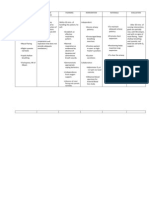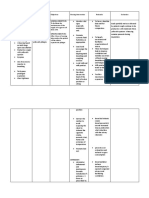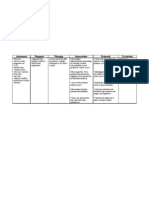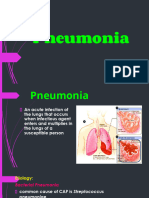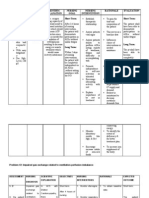NCP - Impaired Gas Exchange
NCP - Impaired Gas Exchange
Uploaded by
Rryje SallevaCopyright:
Available Formats
NCP - Impaired Gas Exchange
NCP - Impaired Gas Exchange
Uploaded by
Rryje SallevaOriginal Title
Copyright
Available Formats
Share this document
Did you find this document useful?
Is this content inappropriate?
Copyright:
Available Formats
NCP - Impaired Gas Exchange
NCP - Impaired Gas Exchange
Uploaded by
Rryje SallevaCopyright:
Available Formats
Assessment Actual Abnormal Cues: Dyspnea Visual disturbances Headache upon awakening Confusion Restlessness Irritability Lethargy Abnormal
Abnormal ABG result Risk factors: Age Stress Smoking Occupation Exposure to airborne irritants
Nursing Diagnosis Impaired gas exchange related to inflammation of that lungs that altered the blood flow as evidenced by verbal reports of difficulty of breathing
Rationale Exposure to irritants
Desired Outcomes After 4 days of nursing intervention the client will be able to: 1.Demonstrate improved ventilation and adequate oxygenation of tissues within clients normal limits. 2. Participate in treatment regimen(e.g, breathing exercises, effective coughing, use of oxygen) within level of ability/situation. 3. Verbalize understanding of causative factors and appropriate intervention.
Intervention Independent: 1. Assess for respiratory depth, rate. Note use of accesory muscles, pursed lip breathing, inability to speak/converse 2. Routinely monitor skin and mucous membrane.
Justification
Evaluation After 4 days of nursing intervention, client was able to:
Toxic injury to endothelial and epithelial cells
1.To evaluate the degree of respiratory distress and chronicity of the disease process. 2.Cyanosis may be peripheral or central. Duskiness and central cyanosis indicates advance hypoxemia 3.Decrease of vibratory tremors suggest fluid collection or air trapping 1.PaCO2 usually is elevated and PaO2 is decreased: hypoxia is present in lesser or greater degree 2.to correct or prevent worsening of hypoxia 3.reduce dyspnea by controlling the anxiety
Accumulation of leukocytes Definition: -Excess or deficit in oxygenation and/or carbon dioxide elimination at the alveoli-capillary membrane.
3. palpate for crepitus
Inflammation of the lungs
Constriction of bronchus
Collaborative 1. Monitor serial ABG and pulse oximetry.
Impaired gas exchange
2. Administer oxygen therapy 3. Administer anti anxiety drugs
You might also like
- 6 Pleural Effusion Nursing Care PlansDocument7 pages6 Pleural Effusion Nursing Care PlansShaina Fe RabaneraNo ratings yet
- Activity Intolerance Related To Decrease Blood FlowDocument3 pagesActivity Intolerance Related To Decrease Blood FlowDarkCeades100% (3)
- NCP Impaired Gas ExchangeDocument1 pageNCP Impaired Gas ExchangeLaidy Aizahlyn Indoc Angod0% (3)
- NCP - Risk For InfectionDocument2 pagesNCP - Risk For InfectionJet Bautista100% (1)
- "Mayroong Namuong Dugo Sa Utak Niya Kaya Hindi Maayos Ang Daloy NG Dugo Rito" As Verbalized by The Patient'sDocument4 pages"Mayroong Namuong Dugo Sa Utak Niya Kaya Hindi Maayos Ang Daloy NG Dugo Rito" As Verbalized by The Patient'sAllisson BeckersNo ratings yet
- NCP Heart FailureDocument2 pagesNCP Heart FailureDayan Cabriga100% (2)
- Fluid Volume ExcessDocument4 pagesFluid Volume ExcessTamil Villardo100% (2)
- Nursing Care PlanDocument2 pagesNursing Care PlanAl RizkyNo ratings yet
- NCP PneumoniaDocument2 pagesNCP PneumoniaChristian Apelo Serquillos100% (2)
- NCPDocument2 pagesNCPDidith AbanNo ratings yet
- Assessment Diagnosis Planning Intervention EvaluationDocument2 pagesAssessment Diagnosis Planning Intervention EvaluationCharissa Magistrado De LeonNo ratings yet
- Nursing Care Plan:: Lopez, Maria Sofia B. 10/18/2020 3-BSN-B Prof. IsananDocument4 pagesNursing Care Plan:: Lopez, Maria Sofia B. 10/18/2020 3-BSN-B Prof. IsananSofia LopezNo ratings yet
- ANOLIN, Marc Edriann T. Nursing Care Plan Assessmen T Diagnosis Rationale Planning Interventio N Rationale EvaluationDocument2 pagesANOLIN, Marc Edriann T. Nursing Care Plan Assessmen T Diagnosis Rationale Planning Interventio N Rationale EvaluationEdrianne Tui100% (2)
- Impaired Gas ExchangeDocument5 pagesImpaired Gas ExchangeKM67% (3)
- Nursing Care Plan: Cystic FibrosisDocument4 pagesNursing Care Plan: Cystic FibrosisYael EzraNo ratings yet
- Impaired Gas Exchange NCPDocument4 pagesImpaired Gas Exchange NCPkimglaidyl bontuyanNo ratings yet
- NCP For Impaired Gas ExchangeDocument2 pagesNCP For Impaired Gas ExchangeSweetie Star94% (16)
- Impaired Gas ExchangeDocument2 pagesImpaired Gas ExchangeHanya Bint PotawanNo ratings yet
- Prioritized Nursing Problem For Pneumothorax Nursing Diagnosis Nursing Intervention RationaleDocument3 pagesPrioritized Nursing Problem For Pneumothorax Nursing Diagnosis Nursing Intervention RationaleJoshua VillarbaNo ratings yet
- Impaired Gas Exchange-Sample NCPDocument1 pageImpaired Gas Exchange-Sample NCPKaycee BinanNo ratings yet
- Final NCP Ineffective Airway ClearanceDocument8 pagesFinal NCP Ineffective Airway ClearanceHazel EndayaNo ratings yet
- FAELDONEA, PJ - Nursing Care PlanDocument6 pagesFAELDONEA, PJ - Nursing Care PlanPatricia Jean Faeldonea100% (1)
- NCP - Altered Tissue PerfusionDocument2 pagesNCP - Altered Tissue PerfusionLeigh Kristel Andrion0% (1)
- NCP Impaired Gas ExchangeDocument2 pagesNCP Impaired Gas ExchangeCharissa Magistrado De LeonNo ratings yet
- NCP For TBDocument3 pagesNCP For TBNelle Agni100% (1)
- Impaired Tissue Integrity BurnDocument1 pageImpaired Tissue Integrity BurntabaloveNo ratings yet
- NCP Impaired Gas ExchangeDocument2 pagesNCP Impaired Gas ExchangeGabriel Tolentino70% (10)
- Nursing Care Plan: References: Nurse's Pocket Guide Pages 151-155Document1 pageNursing Care Plan: References: Nurse's Pocket Guide Pages 151-155Caroline ChaNo ratings yet
- NCP AlteredDocument3 pagesNCP AlteredShaira TillahNo ratings yet
- Nursing Care Plan (NCP)Document3 pagesNursing Care Plan (NCP)Sha PinedaNo ratings yet
- NCP DobDocument2 pagesNCP DobTata Wendz100% (1)
- NCP - Ineffective Airway ClearanceDocument2 pagesNCP - Ineffective Airway Clearancelarapatricia1215No ratings yet
- Ineffective Breathing PatternDocument2 pagesIneffective Breathing PatternEna Katherine CanonoNo ratings yet
- NCP Ineffective Airway ClearanceDocument1 pageNCP Ineffective Airway ClearanceImation DataNo ratings yet
- NCP - Risk For Infection - DMDocument3 pagesNCP - Risk For Infection - DMcessi18100% (1)
- Impaired Urinary EliminationDocument3 pagesImpaired Urinary EliminationAgcopra MtchNo ratings yet
- Fluid Volume ExcessDocument2 pagesFluid Volume ExcessRodel Yacas100% (5)
- Nursing Care PlanDocument5 pagesNursing Care PlanAnju Luchmun100% (2)
- NANDA Page 658Document5 pagesNANDA Page 658Ashley Gaton Alindogan100% (1)
- NURSING CARE PLAN Alvarez - Impaired Gas ExchangeDocument2 pagesNURSING CARE PLAN Alvarez - Impaired Gas ExchangeNader AbdurasadNo ratings yet
- Activity Intolerance NCPDocument3 pagesActivity Intolerance NCPGen Rodriguez100% (1)
- NCP Ineffective Airway ClearanceDocument4 pagesNCP Ineffective Airway ClearanceMary Joyce Limoico100% (1)
- Asthma Risk For Activity IntoleranceDocument1 pageAsthma Risk For Activity IntoleranceWdy Tanakht Sparrow100% (4)
- NCP: Acute GastroenteritisDocument3 pagesNCP: Acute GastroenteritishauteanicoleNo ratings yet
- Ineffective Breathing Pattern Related To Bronchospasm, Decreased Lung ExpansionDocument2 pagesIneffective Breathing Pattern Related To Bronchospasm, Decreased Lung ExpansionReylan Garcia43% (7)
- NCP LocDocument2 pagesNCP LocMel RodolfoNo ratings yet
- Disturbed SleepDocument1 pageDisturbed Sleepmawel100% (1)
- NCP - CopdDocument3 pagesNCP - CopdhystericoNo ratings yet
- Ineffective Breathing Pattern Pneumonia Nursing Care PlanDocument1 pageIneffective Breathing Pattern Pneumonia Nursing Care PlanJasonlee Baluyot100% (1)
- NCP - Difficulty of BreathingDocument2 pagesNCP - Difficulty of BreathingTarquin Tomada33% (3)
- NCP Impaired Skin IntegrityDocument1 pageNCP Impaired Skin Integritysinister17No ratings yet
- Nursing Care PlanDocument4 pagesNursing Care PlanJoshua Pascasio100% (1)
- Impaired Gas Exchange NCPDocument3 pagesImpaired Gas Exchange NCPRomel BaliliNo ratings yet
- Competencymr McdougalcopdDocument17 pagesCompetencymr Mcdougalcopdmac_rymrt7569No ratings yet
- BronchiectasisDocument40 pagesBronchiectasisyana jaeNo ratings yet
- NCP Kochs2Document2 pagesNCP Kochs2Ava VierNo ratings yet
- Chronic Obstructive Lung Disease (COPD) : Is An Obstructive Lung Diseases in Which Irreversible Lung Damage Has OccuredDocument25 pagesChronic Obstructive Lung Disease (COPD) : Is An Obstructive Lung Diseases in Which Irreversible Lung Damage Has OccuredOmar AbdillahiNo ratings yet
- PNEUMONIADocument24 pagesPNEUMONIAwheeyycoldandhot55No ratings yet
- Activity Intolerance NCPDocument6 pagesActivity Intolerance NCPDoo NahNo ratings yet
- Woman With PneumoniaDocument9 pagesWoman With PneumoniaNohaira SADANGNo ratings yet






























